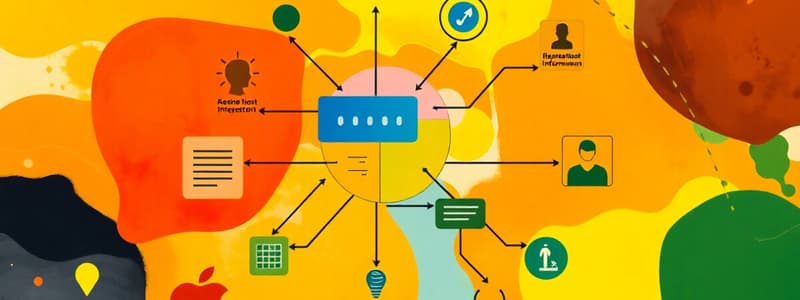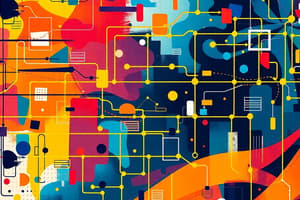Podcast
Questions and Answers
Which of the following reflects the primary role of an Enterprise Information System (EIS)?
Which of the following reflects the primary role of an Enterprise Information System (EIS)?
- To develop and market new software applications for consumers.
- To manage the physical security and access control within an enterprise.
- To facilitate business processes by integrating various organizational functions. (correct)
- To offer consulting services to external clients, focusing on IT strategy.
Which aspect of service is emphasized by an Enterprise Information System (EIS)?
Which aspect of service is emphasized by an Enterprise Information System (EIS)?
- Delivering a high quality of service, especially concerning large data volumes. (correct)
- Limiting the scope of service to only a few, select departments within an organization.
- Providing generic solutions applicable to all types of organizations.
- Focusing solely on cost reduction through automation.
Within the context of Enterprise Information Systems (EIS), which of the following is a key benefit of integrating various business functions?
Within the context of Enterprise Information Systems (EIS), which of the following is a key benefit of integrating various business functions?
- It centralizes all decision-making, ensuring consistency across the organization.
- It streamlines processes, enhances data flow, and improves overall efficiency. (correct)
- It allows each department to operate independently, fostering innovation.
- It reduces the need for specialized software, leading to cost savings.
What is the main reason for companies to transition from independent databases to an Enterprise Information System (EIS)?
What is the main reason for companies to transition from independent databases to an Enterprise Information System (EIS)?
In what way does an Enterprise Information System (EIS) contribute to business management?
In what way does an Enterprise Information System (EIS) contribute to business management?
Which of the following is NOT a typical functional area supported by Enterprise Information Systems (EIS)?
Which of the following is NOT a typical functional area supported by Enterprise Information Systems (EIS)?
How do Enterprise Information Systems (EIS) enhance decision-making within an organization?
How do Enterprise Information Systems (EIS) enhance decision-making within an organization?
What is the role of Enterprise Resource Planning (ERP) within an enterprise?
What is the role of Enterprise Resource Planning (ERP) within an enterprise?
Which of the following activities is primarily supported by Customer Relationship Management (CRM) systems?
Which of the following activities is primarily supported by Customer Relationship Management (CRM) systems?
What is the primary function of Enterprise Content Management (ECM) systems?
What is the primary function of Enterprise Content Management (ECM) systems?
What is the function of Human Resource Management (HRM) systems?
What is the function of Human Resource Management (HRM) systems?
What is the core objective of an Electronic Document Management System (EDMS)?
What is the core objective of an Electronic Document Management System (EDMS)?
What benefit does an Enterprise Resource Planning (ERP) system provide in managing business processes?
What benefit does an Enterprise Resource Planning (ERP) system provide in managing business processes?
What capability does a Customer Relationship Management (CRM) system provide in sales management?
What capability does a Customer Relationship Management (CRM) system provide in sales management?
What is a key focus of Enterprise Content Management (ECM) concerning data in an organization?
What is a key focus of Enterprise Content Management (ECM) concerning data in an organization?
What functionality does Human Resource Management (HRM) software provide in tracking employee-related data?
What functionality does Human Resource Management (HRM) software provide in tracking employee-related data?
What primary goal is achieved through the implementation of an Electronic Document Management System (EDMS) in an office environment?
What primary goal is achieved through the implementation of an Electronic Document Management System (EDMS) in an office environment?
Which of the following is a key capability that 'Marketing Automation' provides as a component of Customer Relationship Management (CRM)?
Which of the following is a key capability that 'Marketing Automation' provides as a component of Customer Relationship Management (CRM)?
What function does 'Sales Force Automation' serve within a Customer Relationship Management (CRM) system?
What function does 'Sales Force Automation' serve within a Customer Relationship Management (CRM) system?
How does 'Contact Center Automation' improve the efficiency of customer support operations?
How does 'Contact Center Automation' improve the efficiency of customer support operations?
What unique marketing opportunity is created through the use of 'Geolocation Technology' in Customer Relationship Management (CRM)?
What unique marketing opportunity is created through the use of 'Geolocation Technology' in Customer Relationship Management (CRM)?
How does 'Workflow Automation' in CRM systems aid in streamlining business processes?
How does 'Workflow Automation' in CRM systems aid in streamlining business processes?
What is the primary benefit of 'Lead Management' within Customer Relationship Management (CRM) systems?
What is the primary benefit of 'Lead Management' within Customer Relationship Management (CRM) systems?
What employee-related information can be effectively managed and tracked through 'Human Resource Management (HRM)' systems integrated with CRM?
What employee-related information can be effectively managed and tracked through 'Human Resource Management (HRM)' systems integrated with CRM?
How is 'Analytics' used within Customer Relationship Management (CRM) to improve customer satisfaction?
How is 'Analytics' used within Customer Relationship Management (CRM) to improve customer satisfaction?
How might 'Artificial Intelligence (AI)' contribute to automating key activities in CRM?
How might 'Artificial Intelligence (AI)' contribute to automating key activities in CRM?
What function does 'Project Management' serve within a Customer Relationship Management (CRM) system?
What function does 'Project Management' serve within a Customer Relationship Management (CRM) system?
Why is the 'Integration with other software' capability important in CRM systems?
Why is the 'Integration with other software' capability important in CRM systems?
How does Cloud-based CRM (SaaS) affect data storage and accessibility for a company?
How does Cloud-based CRM (SaaS) affect data storage and accessibility for a company?
An organization uses a CRM system to allow customers to create fan pages for their products on social media. Which benefit of social CRM does this BEST represent?
An organization uses a CRM system to allow customers to create fan pages for their products on social media. Which benefit of social CRM does this BEST represent?
An Enterprise Content Management (ECM) system offers comprehensive compatibility with various file formats. Which scenario highlights the BENEFIT of ensuring that ECM is compatible with web standards such as XML and HTML files?
An Enterprise Content Management (ECM) system offers comprehensive compatibility with various file formats. Which scenario highlights the BENEFIT of ensuring that ECM is compatible with web standards such as XML and HTML files?
When classifying a product as an Enterprise Content Management (ECM), which of the characteristics listed is MOST crucial for its categorization?
When classifying a product as an Enterprise Content Management (ECM), which of the characteristics listed is MOST crucial for its categorization?
What can companies using Enterprise Content Management commonly rely on ECM to do?
What can companies using Enterprise Content Management commonly rely on ECM to do?
What is the BEST description of why businesses and organizations implement an Electronic Document Management System (EDMS)?
What is the BEST description of why businesses and organizations implement an Electronic Document Management System (EDMS)?
Which objective of Human Resource Management (HRM) focuses on addressing legal issues and social challenges within a company and among its employees?
Which objective of Human Resource Management (HRM) focuses on addressing legal issues and social challenges within a company and among its employees?
What is employee recruitment, onboarding, and retention best described as?
What is employee recruitment, onboarding, and retention best described as?
If HR managers monitor the state of the job market to help the organization stay competitive, what may this include?
If HR managers monitor the state of the job market to help the organization stay competitive, what may this include?
How does Human Resource Management support the goals of an organization?
How does Human Resource Management support the goals of an organization?
When aiming to achieve the goals of an organization, what should a HR manager focus on providing?
When aiming to achieve the goals of an organization, what should a HR manager focus on providing?
Flashcards
Enterprise Information System
Enterprise Information System
A large-scale technological platform that allows a business to merge and systemize all of its processes.
Enterprise System
Enterprise System
Combines various applications and designs to streamline sales, accounting, inventory management, and other business functions.
Enterprise Information Systems
Enterprise Information Systems
Software systems for business management, encompassing modules that support organizational functional areas.
Enterprise Resource Planning (ERP)
Enterprise Resource Planning (ERP)
Signup and view all the flashcards
ERP Methodology
ERP Methodology
Signup and view all the flashcards
ERP System
ERP System
Signup and view all the flashcards
Customer Relationship Management (CRM)
Customer Relationship Management (CRM)
Signup and view all the flashcards
Enterprise Content Management (ECM)
Enterprise Content Management (ECM)
Signup and view all the flashcards
Human Resource Management (HRM)
Human Resource Management (HRM)
Signup and view all the flashcards
Electronic Document Management System (EDMS)
Electronic Document Management System (EDMS)
Signup and view all the flashcards
Customer Relationship Management
Customer Relationship Management
Signup and view all the flashcards
Enterprise Content Management (ECM)
Enterprise Content Management (ECM)
Signup and view all the flashcards
Contact Center Automation
Contact Center Automation
Signup and view all the flashcards
Geolocation Technology
Geolocation Technology
Signup and view all the flashcards
Workflow automation.
Workflow automation.
Signup and view all the flashcards
Lead management
Lead management
Signup and view all the flashcards
Human resource management (HRM)
Human resource management (HRM)
Signup and view all the flashcards
Analytics
Analytics
Signup and view all the flashcards
Artificial intelligence
Artificial intelligence
Signup and view all the flashcards
Project Management
Project Management
Signup and view all the flashcards
Integration with other software
Integration with other software
Signup and view all the flashcards
Cloud-based CRM
Cloud-based CRM
Signup and view all the flashcards
social CRM
social CRM
Signup and view all the flashcards
Societal objectives
Societal objectives
Signup and view all the flashcards
Organizational objectives
Organizational objectives
Signup and view all the flashcards
Functional objectives
Functional objectives
Signup and view all the flashcards
Personal objectives
Personal objectives
Signup and view all the flashcards
Objectives of HRM
Objectives of HRM
Signup and view all the flashcards
Skills of HRM
Skills of HRM
Signup and view all the flashcards
Responsibilities of HR manager
Responsibilities of HR manager
Signup and view all the flashcards
Enterprise Content Management (ECM)
Enterprise Content Management (ECM)
Signup and view all the flashcards
Importance of ECM
Importance of ECM
Signup and view all the flashcards
EDMS
EDMS
Signup and view all the flashcards
Importance of EDMS
Importance of EDMS
Signup and view all the flashcards
Differences of CMS
Differences of CMS
Signup and view all the flashcards
Study Notes
Course Information
- This course is titled "Enterprise Information Systems" at Ankara Yildirim Beyazit University.
- The lecturer is Dr. M. Talha Akpinar.
- Lectures are held on Tuesdays from 11:00 to 12:00 PM.
- Office hours are at ESENBOGA, Tuesday 12:00-14:00.
Course Overview
- Enterprise Information System (EIS) is an information system improves the functions of the business processes by integration.
- EIS provides high-quality service.
- EIS deals with large data volumes.
- EIS supports complex organizations or enterprises.
Course Objectives
- Objective 1: Study theoretical EIS foundations.
- Objective 2: Studying EIS concepts and tools
- Objective 3: Study the current practices of EIS
Course Requirements
- Attendance and Participation: 20 points (2 points per class).
- Course Presentation : 20 points (Group activity)
- Midterm and Final Exams: 60 points (Midterm 20 points, Final 40 points).
Course Policies
- Regular attendance is mandatory.
- Communication is mandatory for interaction and questions.
- Online courses are conducted via AYBUZEM and Zoom.
Required Books and References
- Designing Enterprise Information Systems Merging Enterprise Modeling And Software Specification by Boris Shishkov
- Enterprise Information Systems by David L. Olson, Subodh Kesharwani
- Enterprise Resource Planning and Business Intelligence Systems for Information Quality
- Enterprise systems for management by Motiwalla, Luvai FThompson
- Information Systems Today Managing the Digital World by Joseph Valacich
- Managing Enterprise Resource Planning Adoption and Business Processes by Chuck C.H. Law
Enterprise Information Systems (EIS) Definition
- EIS are large-scale technological platforms that are designed to merge and systemize all of a business's processes.
- An enterprise system combines applications, designs, and procedures to streamline business functions like sales, accounting, and inventory management.
- EIS refers to software systems for business management and includes modules supporting organizational functions like planning, manufacturing, accounting, human resources, etc.
- A key benefit of EIS is the ability to provide a centralized way for everyone to access the same data, leading companies to replace independent databases with EIS.
Components of Information Systems
- Hardware.
- Software.
- Network communications.
- People.
- Data.
- Processes.
Why Organizations need EIS
- To avoid information islands
Popular Software Applications for Enterprise Information
- SAP.
- Salesforce.
- Microsoft.
- Oracle.
ERP (Enterprise Resource Planning)
- An enterprise resource planning(ERP) system automates procedures to create business processes for customer order processing which then includes getting order, invoicing, receiving payment, shipping from the warehouse and delivery to the client.
- Builds an information infrastructure for identification and planning of all the organization's resources.
CRM (Customer Relationship Management)
- Client and main activities are effective marketing, sales, and customer service.
- Customer Relationship Management (CRM) is the combination of strategies, practices, and technologies to manage/analyze customer data throughout their lifecycle.
- CRM supports sales funnels analysis, regional analysis, and sales reports.
- CRM is to improve customer service and retention to drive sales growth.
- CRM compiles customer data across various points of contact between the customer and the company, including the company website, telephone, live chat, and direct mail.
Benefits of CRM
- Customer information such as past purchases are easily accessible, facilitating faster customer service.
- Customer data helps businesses identify trends through reporting features.
- Automation supports sales funnels and tasks.
Components of CRM
- Marketing Automation: Automates tasks to enhance marketing efforts.
- Sales Force Automation: Tracks customer interactions and automates sales functions.
- Contact Center Automation: Reduces monotonous aspects of contact center agents' jobs.
- Geolocation Technology: Integrates technology to create geographic-based campaigns on customers' locations.
More Components of CRM
- Workflow Automation: Streamlines workloads, which allows employees to focus on more creative tasks.
- Lead Management: Tracking and analyzing data for sales leads.
- Human Resource Management: CRM tracks employee information.
- Analytics: Creating better customer satisfaction rates by analyzing user data and targeted marketing campaigns.
- Artificial Intelligence: Automates repetitive tasks to identify customer-buying patterns to predict future behaviors.
- Project Management: Help users to keep track of client project details.
- Integration with other software examples include call centers and ERP systems.
Concerns about CRM
- With improper management, CRM systems may turn into a glorified database
- Duplicate or outdated data can cause challenges.
- Data sets must be connected so users can easily access information.
- Problems can lead to declines in customer experience due to long wait times and improper handling of technical support cases.
ECM (Enterprise Content Management)
- Enterprise Content Management (ECM) systems companies organize, manage, and distribute content, such as documents, images, health records, emails, and web pages.
- ECM presents a basic infrastructure and technical architecture to support the life cycle.
- ECM consists of applications that can interact with each other, also used/sold as separate products.
- Companies use ECM software to store, track, edit, and collaborate on content while maintaining security levels.
Importance of ECM
- ECM is compatible with most file types, serving as a secure platform to store content and facilitate collaboration with ERP systems.
- Should be able to: store large amounts of content, impose data order, make finding resources easy, allow collaboration and ensure data integrity.
General ECM Goals
- The main goal of ECM is for companies to simplify and streamline their work by eliminating paper documents and organizing data to best fit business needs.
- Decrease dependence on paper, streamline productivity, and reduce organized risk.
EDMS (Electronic Document Management System)
- EDMS-system is a document management framework in the company.
- Electronic Document Management System automates creation, logging, storage and archiving in one database.
Importance of EDMS
- Businesses and organizations use EDMS to eliminate redundancy, mundane and error-prone tasks during the daily routine.
- Using document management system features can give employees the ability to eliminate printouts, gain instant access on devices, navigate the relationship between documents, and maintain data/metadata.
###EDMS vs ECM System
- An EDMS is made to optimize documents, an ECM is build to manage unstructured data.
HRM (Human Resource Management)
- The practice of recruiting, hiring, implementing, and managing employees in an organization.
- HRM is employee management with an emphasis in the company in a business.
- Is the process of employing, training, compensating, retain them and developing policies.
- Automated integrated system, and accounting system
- Employees are also knows as "Human Capital".
- Make effective use of employees, reducing risk and maximizing ROI.
- HRM has undergone many changes over the last twenty years, giving it an even more important role in today's organizations.
Importance of HRM
- HRM a crucial part of improving the health of the business.
- HRM monitors the job market to help the organization make sure compensations are fair.
Different HRM Titles
- HR assistant
- HR business partner
- HR manager
- Talent management specialist/manager
Objectives of HRM
- Societal objectives are measurements responding to the challenges of companies and employee needs.
- Organizational objectives are the actions taken that help to ensure the efficiency of the organization.
- Functional objectives are guidelines to keep HRM functioning properly within the organization.
- Personal objectives are resources used to support career developments.
Skills and Responsibilities of HR Manager
- Employee recruitment, onboarding and retention
- Job role assignment and career development
- Compensation and benefits
- Training and development
Studying That Suits You
Use AI to generate personalized quizzes and flashcards to suit your learning preferences.




